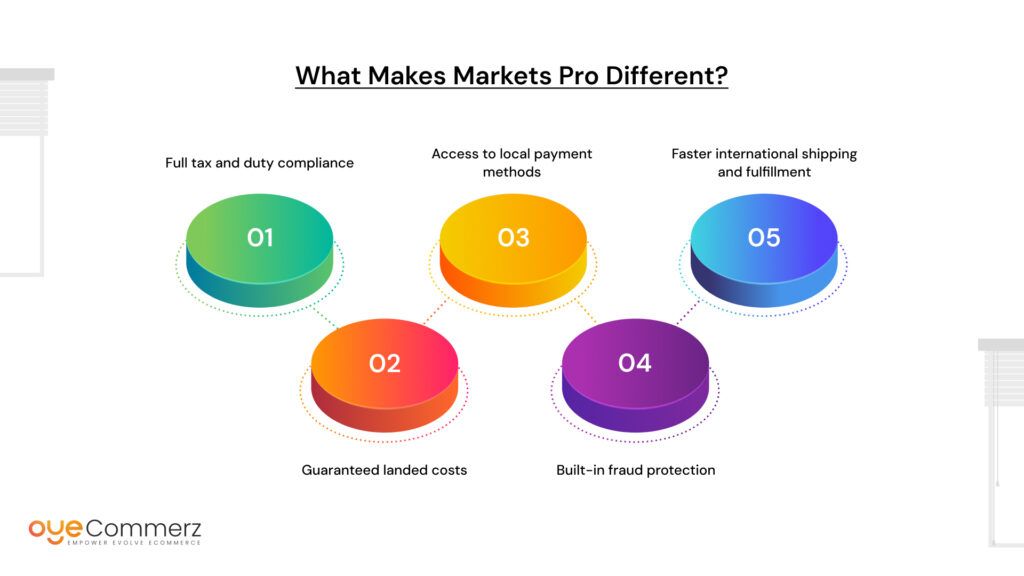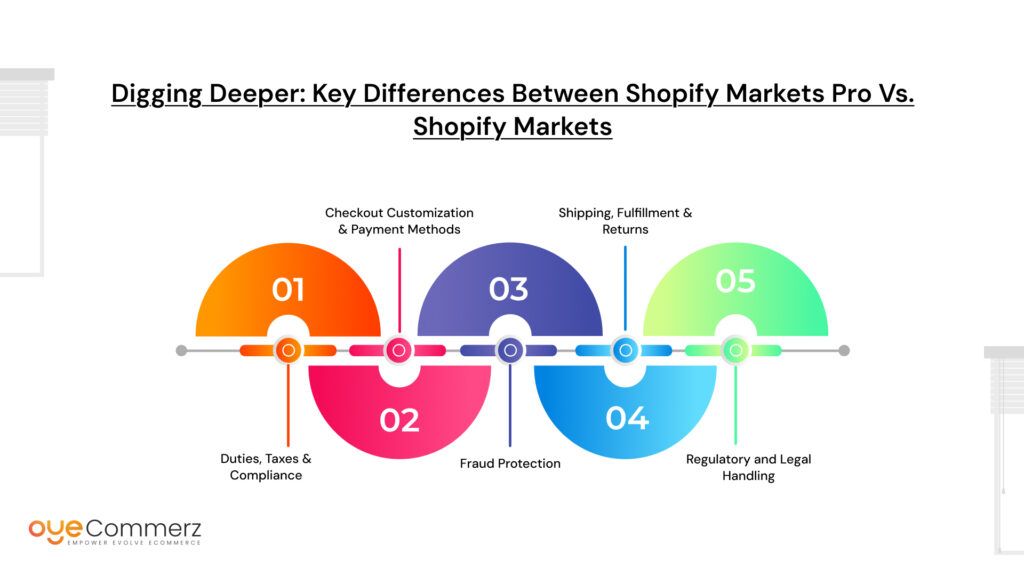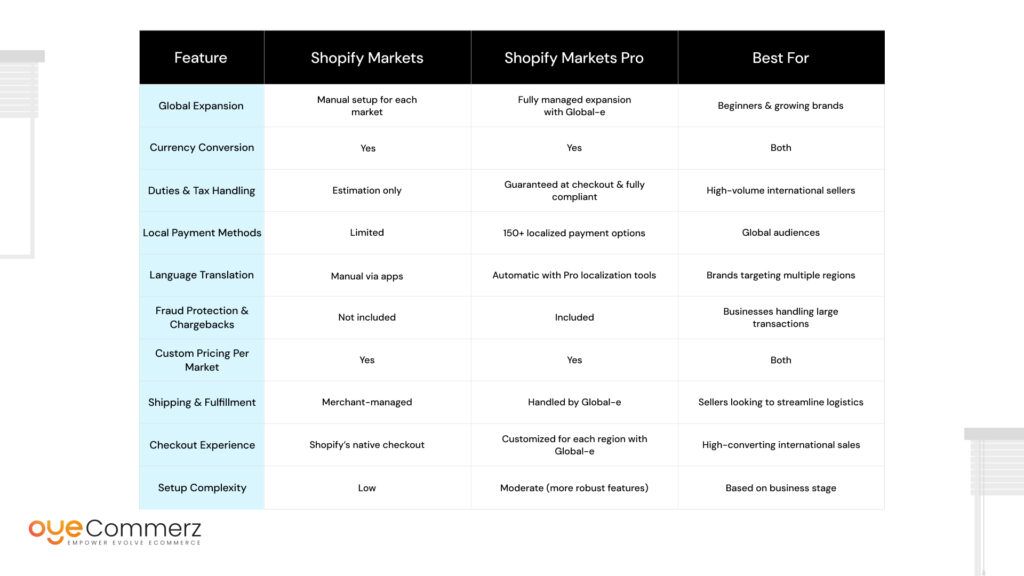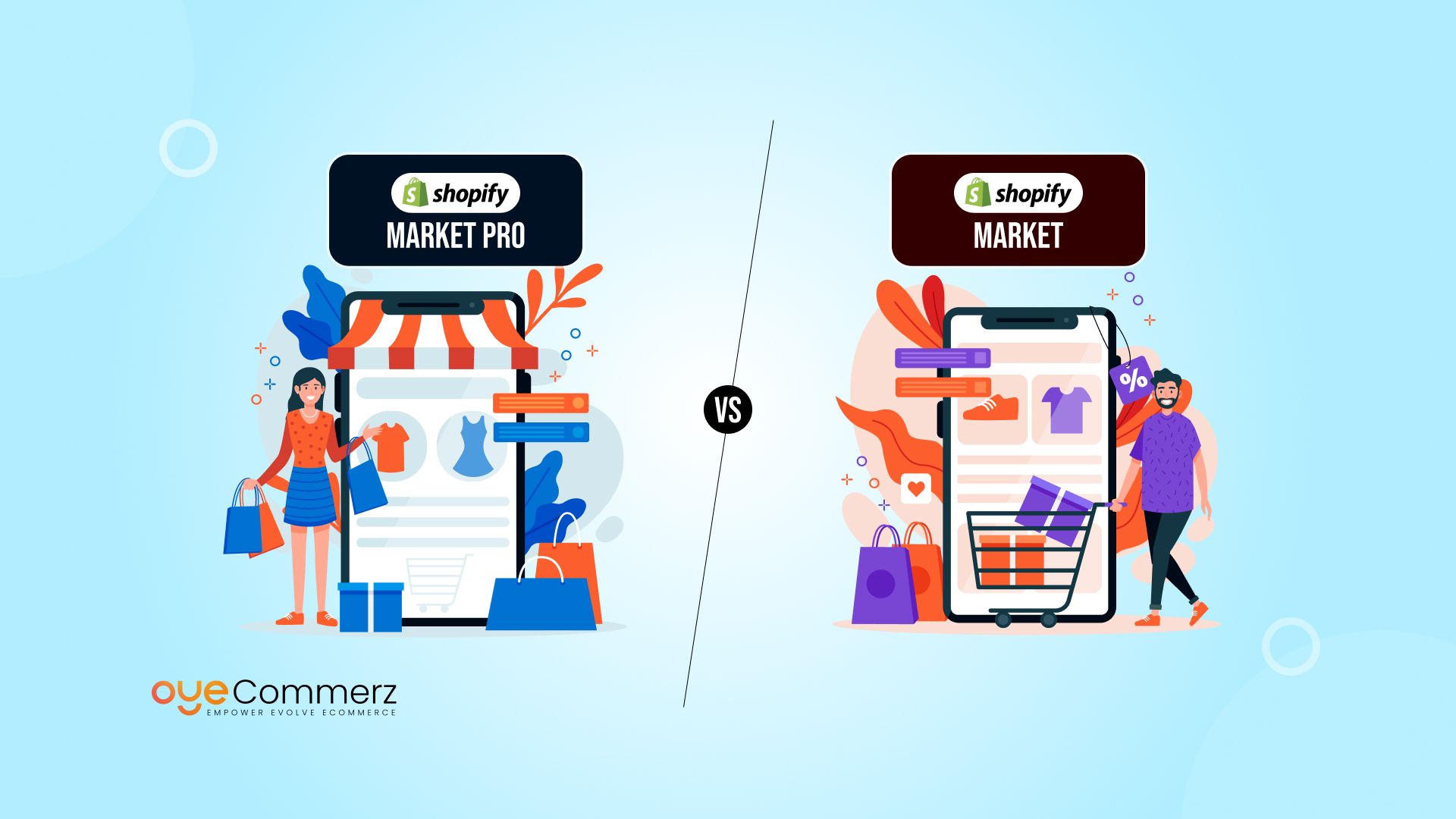Global e-commerce is booming — with cross-border sales expected to surpass $2.2 trillion by 2027, U.S. businesses are under pressure to sell internationally faster and smarter than ever.
But as you explore Shopify’s international selling tools, you’re probably wondering: “Shopify Markets Pro vs Shopify Markets — which one is right for my business?”
That’s the problem. While both solutions are designed to help you reach global customers, the differences between them can be confusing, especially if you’re new to cross-border commerce or transitioning from another platform.
Choose wrong, and you could face challenges like unexpected tax issues, poor localization, or a checkout experience that turns international buyers away.
In this blog, we’ll break down Shopify Markets vs Shopify Markets Pro — from basic definitions to technical differences — so you can make the right decision based on your business size, goals, and global ambitions. Whether you’re just getting started in e-commerce or scaling worldwide with Shopify Migration, this guide has you covered.
Table of Contents
ToggleWhat Is Shopify Markets?
Before diving deep into the Shopify Markets Pro vs Shopify Markets comparison, it’s essential to understand what Shopify Markets offers on its own.
Shopify Markets is Shopify’s built-in tool that helps merchants expand into international markets from a single store — without needing third-party apps or multiple store setups. It’s designed for small to mid-sized businesses in the U.S. looking to start selling globally with minimal complexity.
Key Features of Shopify Markets:
- Localized domains (e.g., .uk, .ca) for each target market
- Currency conversion based on buyer location
- Language translation support to improve international user experience
- Duties and taxes estimation at checkout
- Market-specific pricing and content control
With Shopify Markets, merchants can customize the shopping experience for each country or region while managing everything from a single dashboard. It’s ideal for brands that want to test new markets or expand slowly without overhauling their entire setup.
Think of Shopify Markets as your launchpad — a solid foundation to enter global markets without getting lost in international complexities.
What Is Shopify Markets Pro?

When comparing Shopify Markets Pro vs Shopify Markets, the “Pro” version takes everything a step further — offering more automation, protection, and convenience for merchants who are serious about scaling internationally.
Shopify Markets Pro is a premium solution built in partnership with Global-e, designed to remove the friction and risk of cross-border commerce. It’s ideal for U.S.-based brands that are rapidly growing or already serving multiple countries and want a streamlined way to handle international logistics, compliance, and payments.
What Makes Markets Pro Different?
Unlike standard Shopify Markets, the Pro version doesn’t just help you localize — it handles the backend complexity of global selling for you. That includes:
- Full tax and duty compliance with international regulations
- Guaranteed landed costs at checkout (no surprise fees for customers)
- Access to local payment methods in 150+ countries
- Built-in fraud protection and chargeback coverage
- Faster international shipping and fulfillment through Global-e logistics
Markets Pro shifts the operational burden from your team to Shopify and Global-e — so you can sell internationally with confidence, without needing legal teams, payment gateways, or tax consultants in every region.
If Shopify Markets is the launchpad, Markets Pro is your jet engine for global growth — fast, scalable, and worry-free.
New to E-Commerce? Here’s What You Need to Know First
If you’re just stepping into the world of online selling, the Shopify Markets Pro vs Shopify Markets debate might sound a bit advanced — but don’t worry, this section breaks down the basics so you can understand the full picture.
What Is Cross-Border Commerce?
This simply means selling products to customers outside your home country. For U.S.-based sellers, that could be buyers in Canada, the UK, Australia, or anywhere across the globe.
Why Global Selling Matters
- 70% of online shoppers prefer buying from international stores if the price and shipping are right.
- Expanding globally helps you reach new revenue streams, especially in niche or seasonal markets.
Common Terms You’ll Hear:
- Localization: Adapting your store’s content, language, currency, and pricing to suit the customer’s region.
- Duties & Taxes: Fees imposed by foreign governments when goods are imported. These vary by country and product.
- Landed Cost: The total cost a buyer pays, including product price, shipping, taxes, and import duties.
Why Shopify Helps Beginners Go Global
Shopify simplifies all of this. Whether you start with Shopify Markets or jump into Markets Pro, the platform gives you tools to:
- Sell in multiple currencies
- Translate content for local audiences
- Comply with international tax rules (especially with Markets Pro)
So if you’re a new merchant exploring global potential, understanding Shopify Markets Pro vs Shopify Markets is your first step toward smart, scalable e-commerce growth.
Shopify Markets Pro vs Shopify Markets: Feature Comparison
To help you decide which solution fits your business best, here’s a clear, side-by-side look at the core differences between Shopify Markets Pro vs Shopify Markets:
TL;DR:
- Use Shopify Markets if you’re testing international waters or starting small.
Choose Shopify Markets Pro if you’re scaling fast and need a seamless, automated global solution.
Digging Deeper: Key Differences Between Shopify Markets Pro vs Shopify Markets

Now that we’ve compared them side by side, let’s break down the major differences between Shopify Markets Pro vs Shopify Markets — especially the technical aspects that matter to developers, operations managers, and scaling e-commerce brands.
1. Duties, Taxes & Compliance
- Shopify Markets: Offers estimated duties and taxes at checkout, but these are not guaranteed or automatically remitted. Merchants must handle compliance manually or through third-party tools.
- Markets Pro: Duties and taxes are calculated, collected, and remitted automatically through Global-e. This means you’re compliant with international regulations from day one — with less legal risk and admin overhead.
2. Checkout Customization & Payment Methods
- Shopify Markets: Relies on Shopify’s native checkout with limited regional optimization. Payment methods vary by market but may lack local-specific options.
- Markets Pro: Uses a customized checkout localized for each country, offering over 150 local payment methods (e.g., Klarna, iDEAL, Sofort) — increasing conversion rates globally.
3. Fraud Protection
- Shopify Markets: Merchants are responsible for fraud prevention and chargeback risk.
- Markets Pro: Comes with built-in fraud protection and chargeback handling, reducing operational headaches and financial exposure.
4. Shipping, Fulfillment & Returns
- Shopify Markets: Shipping is merchant-managed using Shopify’s logistics or third-party solutions.
- Markets Pro: Offers end-to-end shipping logistics and international returns through Global-e, with optimized delivery speeds and localized return hubs.
5. Regulatory and Legal Handling
- Shopify Markets: Requires the merchant to navigate legal, tax, and customs compliance across regions.
- Markets Pro: Handles compliance automatically, acting as the merchant of record in many jurisdictions — which shifts legal responsibility away from the seller.
Bottom Line:
If your business is ready for serious international growth, the technical advantages of Shopify Markets Pro vs Shopify Markets make a strong case. Pro isn’t just a feature upgrade — it’s an operational powerhouse for going global with less friction.
Shopify Markets Pro vs Shopify Markets: Pricing & Availability
When comparing Shopify Markets Pro vs Shopify Markets, pricing and access are key factors — especially for small to mid-sized U.S. businesses planning for growth.
Shopify Markets: Free & Built-In
- Cost: Included with all standard Shopify plans (Basic, Shopify, and Advanced).
- Availability: Accessible to all merchants by default — no application required.
- Ideal For: Merchants testing global sales or expanding gradually without added fees.
Shopify Markets Pro: Premium, With More Power
- Cost: No monthly fee, but Shopify charges a percentage-based fee on international orders processed through Markets Pro (typically around 6.5% of the order value). This covers duties, taxes, fraud protection, and logistics.
- Availability: Currently exclusive to U.S.-based merchants. You’ll need to apply or request access via your Shopify admin or contact Shopify support.
- Ideal For: Fast-scaling brands that want full-service global commerce without hiring an international team.
Pro Tip: While Markets Pro adds a transaction-based fee, it can save you money on third-party tax tools, compliance services, chargeback protection, and international fulfillment — making it a smart investment for businesses going global.
Contact to Migrate your Site to Shopify Now
Shopify Markets Pro vs Shopify Markets: Which One Should You Choose?

Still unsure which way to go? Choosing between Shopify Markets Pro vs Shopify Markets comes down to your business size, international goals, and resources.
Here’s a quick decision guide to help you figure it out:
Choose Shopify Markets if:
- You’re just starting to sell internationally
- You want to test a few countries before scaling
- You prefer managing duties, taxes, and shipping yourself
- Your order volume is relatively low
- You’re comfortable using apps for translation or localization
Best for small to mid-sized businesses expanding gradually.
Choose Shopify Markets Pro if:
- You’re seeing strong international demand
- You want full automation for taxes, duties, and compliance
- You’re concerned about fraud and chargebacks
- You want faster shipping and localized returns without third-party setups
- You want to offer regional checkout and payment methods to boost conversions
Best for scaling brands that need global infrastructure without building it in-house.
Quick Tip:
Think of it this way — Shopify Markets gives you control. Markets Pro gives you peace of mind.
Still stuck between the two? Don’t worry — in the next section, we’ll show you how Oyecommerz can help you migrate to Shopify and choose the right setup for your international growth.
Migrating to Shopify for Global Selling? Let Oyecommerz Help
Expanding globally through Shopify Markets Pro vs Shopify Markets is an exciting prospect, but making the right choice — and executing the migration smoothly — can be a challenge. That’s where Oyecommerz comes in.
Why Choose Oyecommerz for Your Shopify Migration?
Oyecommerz specializes in helping businesses migrate seamlessly to Shopify, including setting up Shopify Markets or Shopify Markets Pro for optimal international sales. Whether you’re migrating from platforms like Magento, WooCommerce, or Squarespace, we ensure you’re ready for global success — no matter your starting point.
Here’s how Oyecommerz can help:
- Expert Shopify Migration: We handle everything from the technical setup to data transfer, ensuring no interruptions to your business operations.
- Markets Setup: We’ll guide you through the decision-making process of Shopify Markets Pro vs Shopify Markets, helping you choose the right solution based on your needs.
- Localization & Global Integration: Whether it’s translating content, setting up local payment options, or automating duties and taxes, we set up everything for maximum international growth.
- Ongoing Support: Our team offers continuous support and optimization for your Shopify store, ensuring smooth performance as you expand into new markets.
Global Success Starts with the Right Partner
Shopify is an incredible tool for growing your global presence, but you need an expert partner to navigate all the complexities. Oyecommerz can be that partner, providing you with the support needed to leverage Shopify Markets or Shopify Markets Pro effectively.
Ready to make the leap to international selling? Let’s get your Shopify store set up and ready for success. Contact Oyecommerz to start your migration today!
Conclusion
Deciding between Shopify Markets Pro vs Shopify Markets is a crucial step for any U.S.-based merchant looking to expand globally. Whether you’re just dipping your toes into international sales or you’re ready to scale with a fully automated, risk-free solution, Shopify offers powerful tools to help you succeed.
Key Takeaways:
- Shopify Markets is ideal for businesses starting small and gradually expanding their global reach. It’s cost-effective and manageable, offering a straightforward path to international sales.
- Shopify Markets Pro is designed for high-growth businesses that need automated tax handling, compliance, fraud protection, and seamless logistics to scale quickly and efficiently.
Need Help Migrating or Setting Up Your Shopify Store for Global Selling?
If you’re ready to take your business to the next level with Shopify Markets Pro or Shopify Markets, Oyecommerz is here to help. We specialize in Shopify migration, global integration, and ongoing optimization — ensuring you’re ready to tap into international markets smoothly and successfully.
Contact us today to get started with your Shopify migration and set your store up for global success!
Frequently Asked Questions
Shopify Markets is a basic tool for international sales, allowing merchants to manage regions, currencies, and taxes. Shopify Markets Pro is a premium version offering automated duties, taxes, global payment methods, and fraud protection, ideal for fast-growing businesses.
- Basic Shopify: For new businesses with basic e-commerce features.
- Shopify: Includes advanced reporting and lower transaction fees for growing businesses.
- Advanced Shopify: Best for large businesses with more reporting and shipping options.
Shopify Plus: Enterprise-level with customizable features and dedicated support.
It means you can target up to 3 international markets with a single Shopify store, including local currencies, taxes, and content.
Shopify Payments is Shopify’s built-in payment gateway, allowing you to accept payments directly with lower fees and better integration, without needing third-party processors.
Focus on optimizing product pages with keywords, creating quality content, improving site speed, and making your store mobile-friendly for better SEO performance.




